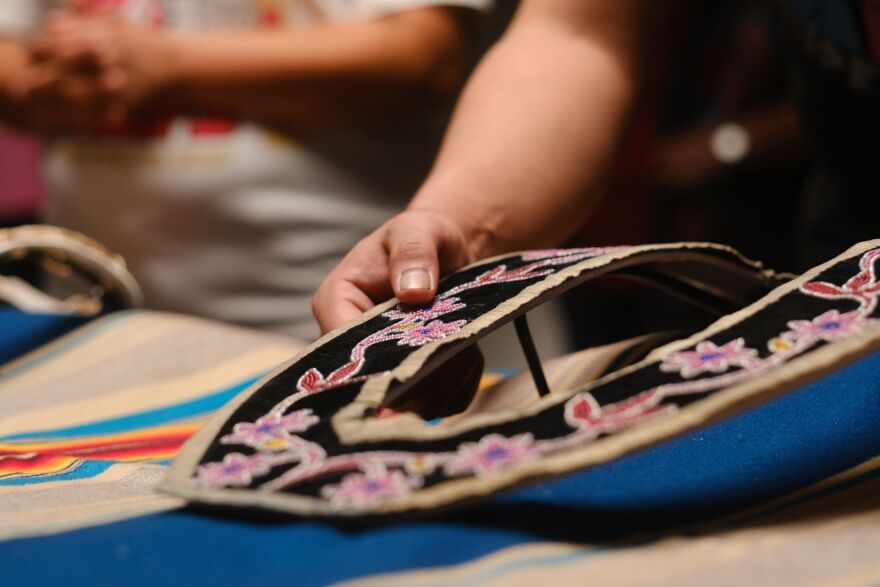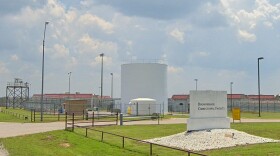Along with the film's release, the museum will share an accompanying book, detailing its reunification process and sharing additional stories that the film may have left out.
Inside a conference room at the First Americans Museum, MaryAnn Guoladdle Parker flips through the new WINIKO: Reunions book, which she co-authored. Parker is a curator at FAM and a Kiowa citizen from Hog Creek near Anadarko.
"So my essay is actually titled 'Reuniting the Past, the Present and the Future,' and I mostly just talked about how the tribal members felt coming into this and the process of it," Parker said.
The process Parker mentioned involves an Indigenous approach to treating museum artifacts — and the communities they come from — with extra care. In the case of the WINIKO: Reunion book and film, it meant Parker going out in the Indigenous communities in Oklahoma with a gift and gratitude for the knowledge she was gleaning.
This Indigenous approach is what FAM's Director of Curatorial Affairs, Dr. heather ahtone (Choctaw/Chickasaw), calls the four R's: reciprocity, responsibility, relationship and respect.
"At FAM, we do not simply see the objects," ahtone said in a statement. "We see the hand of the maker. We see the prayers and knowledge embodied by these items. We see the objects as relatives."
The Caddo word "Winiko," pronounced WIN-eh-COH, does not have a direct English translation, but a close English definition is "life of an object" or "everything on earth, in the universe, and beyond."
Inside the First Americans Museum, colors brighten the galleries and the Indigenous aesthetics create a welcoming feeling. In the WINIKO gallery on the second floor, the cultural materials come from the holdings of the Smithsonian's National Museum of the American Indian, and they have extended labels, showcasing the descendants of the ancestors who were originally associated with the cultural items.
"It's a picture of the descendant and also the ancestor on the label," Parker explained. "So it's also connecting like then and now, how we are living people and not people of the past."
This idea is at the center of both the WINIKO: Reunions book and film, which prompts viewers to reconsider the separation of museum artifacts from the communities from which they come.
The standard museum barrier of glass was absent during this reconnection process, allowing Indigenous relatives to share songs, pick up the objects and feel their textures.
"I think other institutions can look at this film and book as a how-to work with tribes and kind of reunite these objects," Parker said.
The reunification did not necessarily mean the objects could return home to the tribal communities, but it offered a chance for Indigenous individuals connected to the items to rekindle a piece of their ancestral heritage and inspire creativity in potentially recreating these cultural practices.

"You know, life of the objects, life of us — it's just more of like making do with what we got and making the best of it as much as we can," Parker said. "Because there's been a lot of hard things and hard times, especially for Native people. And it's really just like prevailing and thriving in spaces that really aren't made for us, especially museums… So like breathing our own Native life back into these types of objects and things."
Both the WINIKO: Reunion book and documentary will be available to the public this Saturday at the First Americans Museum in Oklahoma City.
The first screening of the film begins at 12:15 p.m. in the Five Moons Theater, with additional screenings scheduled every hour on Saturday afternoon. A panel discussion will also be held at 1:30 p.m. Admission to see the film is $5.
While the film and book wrap up a five-year-long project, Parker said she hopes this reconnection endeavor continues.
"I do hope we're able to be able to do that here as much as we can at FAM," Parker said. "But also encouraging other institutions to look at this work and seeing that they can work with tribes in a positive way and build those relationships with them."
For more information about the WINIKO project, visit the First Americans Museum website.
This report was produced by the Oklahoma Public Media Exchange, a collaboration of public media organizations. Help support collaborative journalism by donating at the link at the top of this webpage.











